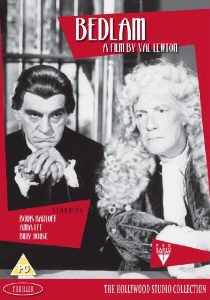
If you like classic horror, then you will probably know you're in for a treat when you see Boris Karloff's name attached to a project, as it is here. Add to that a screenplay by Val Lewton and visuals straight from 18th Century British engraver William Hogarth, and what you have is a charming, well-observed period piece, as much a document of the 1940s as it is the 1700s. I first encountered Bedlam on VHS - and I enjoyed it, although the print quality left a lot to be desired and the cassette gave up the ghost before the end (ah, video - halcyon days!) Therefore it was a real treat to see a clean, functional and, ahem, complete version of this film.
The year is 1761 - the 'Age of Reason', as we're informed. We start the film at the hospital which has bequeathed its nickname to the English language as a term meaning 'uproar and confusion': this is Bethlem Hospital, or Bedlam - and we see a would-be escapee fall to his death from one of the windows before we cut from this sorry scene to one of affluence; the idle, wealthy Lord Mortimer (Billy House) and his feisty female companion Nell Bowen (Anna Lee), who happen to be passing Bedlam in their carriage. A warden approaches the carriage and tells Mortimer that the dead man was known to him. He was a man called Colby, a poet, someone who had promised to perform for Mortimer and his guests at an upcoming evening of entertainment. Perturbed, Mortimer requests that the Apothecary General of Bedlam - one George Sims (Karloff) calls on him the following day to account for this event.
Sims duly arrives at Mortimer's house and, with a combination of tact and guile, not only explains away the accident, but offers the talents of some of his inmates - his 'Bedlamites' - as a replacement act. Mortimer is amused by this suggestion, but Mistress Bowen is more curious. She decides to visit the hospital beforehand, but her first experience of 18th century mental health care distresses her to say the least. Tellingly, she makes an enemy of Sims before she leaves, striking him across the face.
When she departs, she encounters the dashing Quaker William Hannay, who interrogates her about her visit. He insists that her disgust for the conditions within the hospital point to her innate goodness; she insists she was disgusted only on a personal level, and not for the 'wild beasts' themselves, but he has planted the germ of an idea… and the night of the performance itself only reaffirms for Nell that she really is disturbed by the patients' treatment (not least when Sims kills one boy by painting him entirely gold - an understated but unpleasant scene, perhaps more so than its better-known echo in a certain Bond film). Perhaps Hannay was right. Together, they start to discuss how they might reform Bedlam: Mortimer sits on the council, after all, and all they're asking for is the simple things - clean bedding, adequate food.
However, Sims is quick to show his Machiavellian side when he feels his autonomy is being threatened. He starts by putting Mistress Bowen out of favour with her patron, thus leaving her destitute. A comedy of errors ensues: Mistress Bowen's scandalous parrot (!) takes up the cause, and even John Wilkes gets involved with some of the political machinations which arise - but, ultimately, you should take care who you insult in corrupt London, especially if he's an asylum keeper. Mistress Bowen finds herself as an inmate of Bedlam - and it's down to the dashing Quaker to set things right.
This is high melodrama: in many ways it feels more like a stageplay than the more modern films we're used to in its delivery, script and performances. That isn't to denigrate the level of observation here, though: the sets are fantastic and the costumes are great, with lots of historical accuracy via references to 18th century institutions, politics and faith. Of course, Hogarth makes up a large part of the visual style of the film, from the use of his engravings at the start through to some of the scenes being directly modelled on The Rake's Progress. These are lovely touches, and they show the level of research involved. Karloff is on good form here, as always: he is by turns simpering, glowering and magnetic, and it's a treat to see him get his teeth into playing 'the bad guy'.
This film is definitely an unusual one, mixing the absurd with the stately, and the gentle with the unsettling - though threat here is suggested, rather than shown outright. There are no scenes of bloodshed at all. This is a quietly creepy old Gothic, and - although you may pick up on a certain post-colonial chip-on-the-shoulder as expressed by the free thinkers (with soft American accents!) rebelling against a corrupt old order, it's not outright enough to overpower the other elements or to detract from some deft plot development, especially towards the film's close. If you like your classics, then this would be a good addition to your collection.
The quality of this print is very good. As a black and white Gothic, of course shadows and low levels of light form part of the general look of the film, but here we have good contrast levels, rich, glossy blacks and clear, well-balanced light tones. There is an inevitable amount of wear and tear on films of this vintage, but any effects of that here are incredibly minimal (bearing in mind also that I was looking for flaws). The sound quality is crisp and clear and the soundtrack itself sounds really good.
This DVD is chaptered into twelve parts, and also features a photo gallery.
Review by Keri O'Shea
| Released by Odeon Entertainment Ltd |
| Region 2 - PAL |
| Rated 18 |
| Extras : |
| see main review |